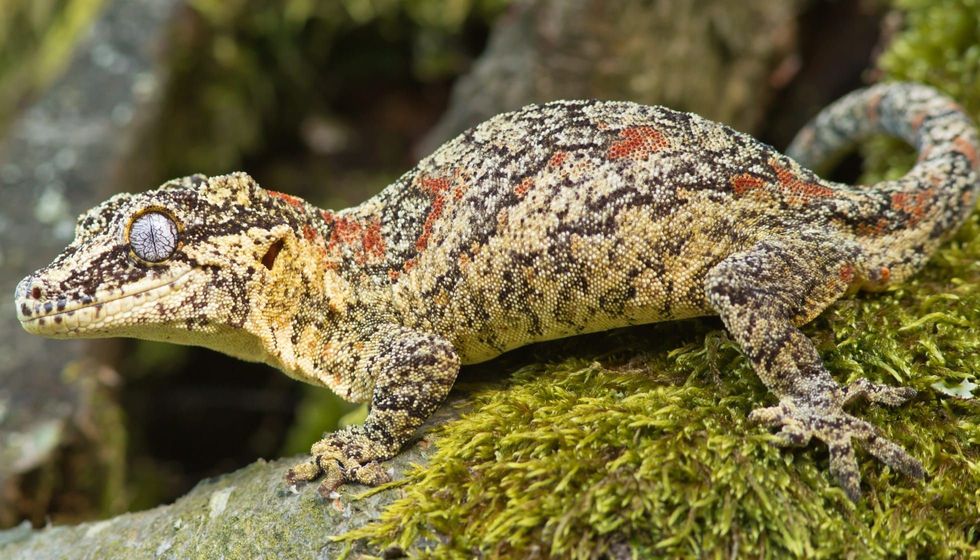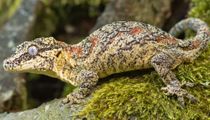Gargoyle geckos are medium-sized lizards or geckos and are famous for their cranial bumps, enclosure requirements like the extremely humid habitat, and particular omnivorous diet. The gargoyle gecko's diet consists of live insects and soft fruits and they must have live plants in their tanks.
They are hunted by small mammals and their species has a regenerative tail. They are quite friendly and get along with humans quite easily.
These geckos have become quite popular pets among reptile lovers in the United States as they are quite easy to breed indoors.
These gargoyle geckos do well in captivity provided they get the proper care. Gargoyle gecko care could be a little complicated as they have a very specific preference for their habitat so enclosure setup and maintenance are very important.
To know more about these interesting geckos, continue reading. If you like reading about various reptiles, then do check our articles on golden-tailed gecko and bearded dragon facts too.
Gargoyle Gecko Interesting Facts
What type of animal is a gargoyle gecko?
A gargoyle gecko is a type of lizard species of the Rhacodactylus genus.
What class of animal does a gargoyle gecko belong to?
The gargoyle gecko (Rhacodactylus auriculatus) belongs to the class of Reptiles within the animal kingdom.
How many gargoyle geckos are there in the world?
Gargoyle geckos might not have a global distribution. They have a distribution area of 7722 sq mi (20,000 sq km) with a population surpassing 10,000 individuals easily.
Where does a gargoyle gecko live?
Gargoyle geckos have limited distribution. They are found on the small islands of New Caledonia which is a French territory of dozens of islands in the south Pacific Ocean. Wild gargoyle geckos are found only on the southern islands and so are often referred to as the New Caledonian bumpy gecko.
What is a gargoyle gecko's habitat?
Gargoyle geckos are very particular about their habitat. The gargoyle gecko habitat is typically tropical and extremely humid. Gargoyle geckos are tree-dwelling reptiles and they prefer a very moist climate with dense vegetation and humidity level within 50-70% ideally.
Who do gargoyle geckos live with?
Adult gargoyle geckos can be very aggressive towards each other, especially male gargoyle geckos. Males of this species, in the company of female gargoyle geckos, may fight against one another for superiority.
In their natural habitat as well, adult gargoyle geckos are quite aggressive, and cannibalism (preying on your species) of eggs, tails, and other parts is very common. In captivity or their natural habitat, a male gargoyle gecko can live with several females but not with other males. However, females show aggressive behavior only in captivity.
How long does a gargoyle gecko live?
A gargoyle gecko's lifespan is about 15 to 20 years in captivity. Their lifespan in their natural habitat is similar but they face more threats in the wild from predators like feral pigs, rodents, and other such mammals. The major threat they face is the degradation of habitat by deforestation, wildfires, and urban expansions.
How do they reproduce?
A juvenile gargoyle gecko reaches sexual maturity at two years and only then should they be allowed to breed or mate. The mating process is quite rough for reptiles and it often leads to injuries and loss of the tail.
After mating, females lay two eggs per clutch 20 to 35 days later. They lay eight to nine clutches throughout the year and the eggs have an incubation period of 60 to 90 days.
Females usually lay their eggs deep in the substrate or a lay box. Males should be removed and housed separately to protect the mother and eggs.
What is their conservation status?
The International Union for Conservation of Nature (IUCN) has listed the gargoyle gecko as ‘Least Concern' due to its distribution and presumed growing population surpassing 10,000 individuals. These gargoyle geckos live deep in the islands of New Caledonia and so they face a major threat from climate change, deforestation, wildfires, and urban expansion.
However, they have recently become quite popular and attractive as pets.
Gargoyle Gecko Fun Facts
What do gargoyle geckos look like?
Gargoyle geckos are small to medium lizards reaching a length of around 7-10 in (17-25 cm) and weighing about 2.1-2.4 oz (60-70 g). These geckos come in a variety of colors like green, yellow, red, orange, and brown with various patterns and stripes all over the body and the gargoyle gecko morphs to camouflage.
Their colorful appearance makes them very good terrarium animals, and mostly why people house them as pets.
Gargoyle geckos have triangular heads, stocky bodies, and big round eyes.
Gargoyle geckos get their name due to the unique cranial bumps over their head like that of a gargoyle's which look like horns or ears. Like all lizards, they also have a regenerative prehensile tail and tiny toe pads which makes them semi-arboreal.
How cute are they?
Gargoyle geckos can be considered quite cute because of their unique cranial bumps over their heads and their coloration and patterns all over the body.
How do they communicate?
Gargoyle geckos communicate through a series of barks, squeaks, and growls with other gargoyle geckos around. They are most vocal during the night. In captivity, they often direct these sounds toward their keeper as well.
How big is a gargoyle gecko?
Gargoyle geckos are the smallest species among the six species of the Rhacodactylus genus of lizards. These species reach a length of 7-10 in (17-25 cm) approx. The gargoyle gecko size might be the smallest in its genus but when it comes to the gargoyle gecko vs crested gecko, they are bigger than crested geckos.
How fast can a gargoyle gecko move?
The exact speed of gargoyle geckos is not known but they are quite fast movers especially when they have to fight against their own or run away from a predator.
How much does a gargoyle gecko weigh?
An adult gargoyle gecko weighs around 2.1-2.4 oz (60-70 g) approximately. They are heavier and longer than their nearest cousin the crested geckos and are much larger than common house lizards.
What are the male and female names of the species?
Geckos in general don't have any specific names for their females and males. They are referred to as male gargoyle geckos and female gargoyle geckos.
What would you call a baby gargoyle gecko?
Babies of gargoyle geckos which have just hatched are called hatchlings. Juvenile gargoyle geckos or hatchlings weigh around 0.11 oz (3 g) and are about 1 in (2.5 cm) long from snout to vent.
What do they eat?
Gargoyle geckos like most geckos are omnivores in nature. They prey on small insects and also eat soft fruits.
In captivity, they do well with a powered gargoyle gecko diet that is mixed with water to make a gecko smoothie. Gargoyle gecko food is easily obtainable from brands that specialize in reptile food. Feeding them once every day is enough.
Are they aggressive?
Yes, males, in particular, are quite aggressive. It is very important to make sure that they are acquainted with the gecko they are about to breed with.
Male gargoyle geckos do well in the company of female geckos but in the company of other males, they tend to fight against each other to establish superiority. If you want to pet multiple geckos, it is advised to house them separately in case they don't like each other.
Would they make a good pet?
Yes, they make great pets for first-time keepers and novices. Gargoyle geckos have very easy-to-meet requirements for tank setup.
They also adapt to human touch very easily as they don't have to hunt for food when they are around a human keeper. They are very particular about their habitat, so a tank setup needs to be ideal for them to survive and thrive. The tank must contain a substrate mixed with sand and should have a basking spot.
Their tank's humidity level must not go down below 50% and has to be misted twice a day. Natural plants are preferable over plastic plants for the tank as they keep the humidity levels more efficiently.
Did you know...
Pangea hatch is often used as a substrate or in laying boxes for gargoyle geckos.
The illegal trading of gargoyle geckos has declined since they are easy to breed.
How much does a baby gargoyle gecko cost?
A baby red-striped gargoyle gecko can cost $389.95 to $1,279.00 and most other gargoyle gecko babies cost similar to the red gargoyle gecko babies. Gargoyle gecko prices vary according to their coloration, patterns, age, and sex.
Their cost of maintenance is lower than most geckos as gargoyle geckos require low-wattage lighting but also require particular temperatures and humidity to survive and thrive.
How to care for a gargoyle gecko?
Gargoyle geckos are easy to care for as they have very easily available requirements for their tank setup. A 10 gal (45 l) tank for a single individual, a 20 gal (91 l) tank for a pair, and live plants are all they need.
Males should not be kept together as they don't get along even in the wild, and mostly fight one another.
The tank's humidity level should ideally never go below 50% and should be within 70% for them to thrive in captivity and a shallow water bowl should be placed so they can be hydrated well enough.
Gargoyle geckos require a very particular diet of live insects and soft fruits in the wild but can be fed powdered food in captivity. A gargoyle gecko tank should ideally have a substrate consisting of coco fiber mixed with peat moss.
This reptile enclosure requires less enclosure with minimum lighting as they are nocturnal, especially in the wild. Gargoyle gecko temperature is ideally between 78-82 F (26-28 C).
The temperature should not be over 87 F (31 C), if so place them in a cool spot for them to cool down.
During winters, the temperatures may drop to 60 F (16 C) but they will adjust to it.
A gargoyle gecko enclosure must be separated to make sure geckos have their private spots as well as get along very well. It is also very important to check for nibble marks or gargoyle gecko bite marks among bonding pairs every week because they could dislike each other after two years of living together.
Here at Kidadl, we have carefully created lots of interesting family-friendly animal facts for everyone to discover! Learn more about some other reptiles including the crested gecko or African fat-tailed gecko.
You can even occupy yourself at home by drawing one on our gargoyle gecko coloring pages.









